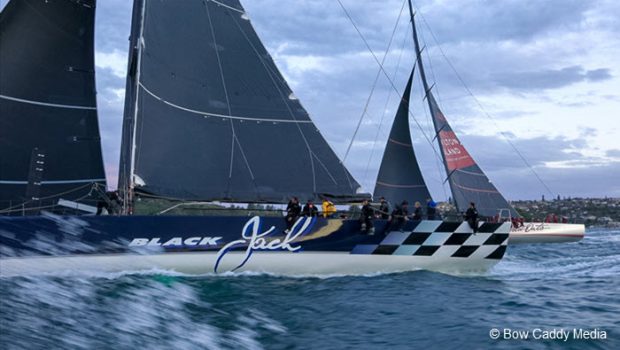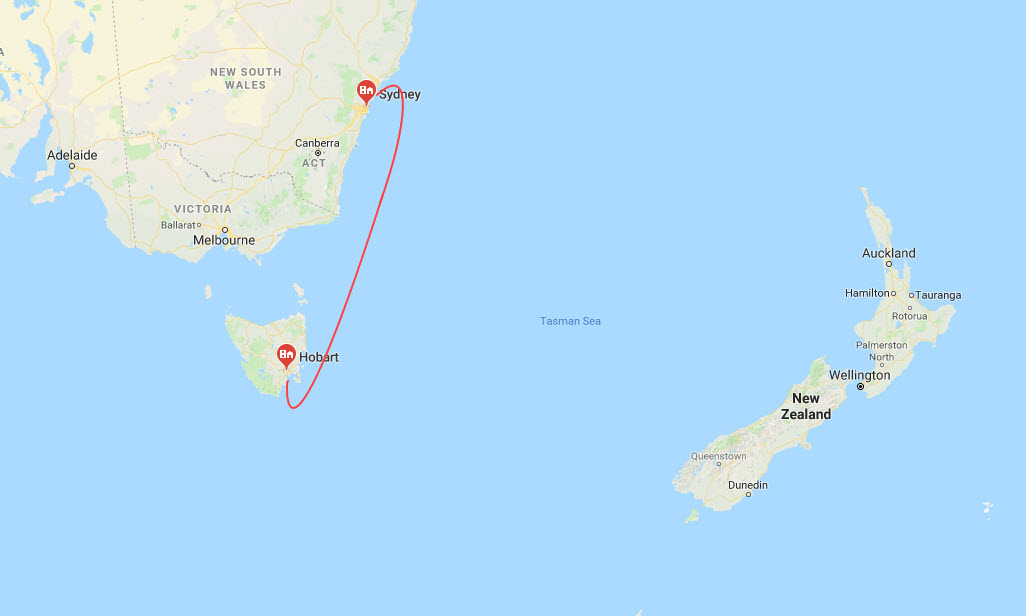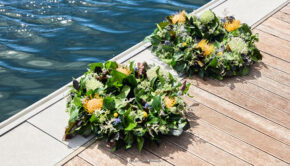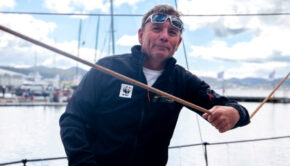Latest in Super-maxi design surgery
Published on December 18th, 2019
When the fleet gets underway for the 628nm Rolex Sydney Hobart Yacht Race on December 26, the spotlight shines brightest on the boats built to the maximum permittable length – the 100 footers. Among this group are two legends, Wild Oats XI and Black Jack (formerly Alfa Romeo), that have been at loggerheads for elapsed time honors since their 2005 launch.
But keeping these two iconic canting keelers current requires work, and both teams went back to their creators, Reichel/Pugh Yacht Design, for answers. Here’s a report from the designers:
In 2019, the Reichel/Pugh Design Team had the opportunity to further develop the performance of their 100-foot Super-maxi designs Wild Oats XI and Black Jack 100. Each team wanted to increase performance in the areas where they felt would have the most impact.
For Wild Oats XI, this meant strengthening the light-wind capability, with a particular emphasis on light air performance, balance, and weight savings, while for Black Jack 100, the efforts were more focused on off-wind performance in the bigger breeze.
After previous work with Wild Oats XI on the bow modifications in 2015 and with Black Jack 100 for the extensive refit in 2017 and a new keel in 2018, the Reichel/Pugh team was well-positioned to offer a competitive advantage to both teams, with work getting started early in 2019.
The Wild Oats XI research began with an extensive design study to evaluate the current performance of the boat in terms of speed, but also balance and maneuverability. The design efforts were led by Reichel/Pugh naval architect David Oliver, in close collaboration with John Reichel, leading CFD specialist Giorgio Provinciali, foil engineer Paul Bieker, and structural engineer Skip Miller from CCG.
Beyond this design team was an extensive network of specialist suppliers, boatbuilders, and project manager Paul Magee who did a phenomenal job ensuring all parties had the information needed and critical decisions were made by the team. No small task with so many moving pieces in play.
The design work began with a full assessment of the existing boat and appendages, including the rudder, canting keel, twin daggerboards, and forward bow ‘flap’. Critical aerodynamic research came from North Design Services, whose RANS testing allowed for precise yaw and balance calculation with the various sail sets and appendages accounted for.
Once the design team had a clear picture of where the boat was in 2018, and understood what effects needed correcting, they set about testing a variety of options to achieve the desired performance improvement. The critical factor was the necessity to maintain balance across a wide variety of headsail configurations.
In the existing configuration, light air balance with the upwind Code 0 required use of all appendages down, and still resulted in negative rudder angles. A difficult scenario which we are very impressed how easy skipper Mark Richards made driving this configuration look!
Outright performance under any individual headsail was ever so slightly better using a twin asymmetric dagger board configuration when positioned appropriately, but when considering the full range of sails and wind conditions, the center of effort moves quite significantly fore and aft, and balance with a twin board arrangement quickly lost the edge.
Thus, the centerline, steerable, daggerboard was the best solution and allows for a wide range of adaptability with unmatched handling. Additionally, it proved to be significantly lighter and less wetted surface than the existing boards. Add in the retractability when sailing downwind and it was the clear choice.
In some senses the design was an evolution of the concept used on Black Jack 100, but the design team took a clean-sheet approach at the outset, and every aspect of the board was designed fresh to be uniquely tailored to Wild Oats XI. We can’t go into detail here, but suffice to say these are not the same boards.
Black Jack 100 began 2019 with a much different mission. The team has been quite happy with the gains made with each of the previous year’s modifications and were looking for the next big step up. The R/P team knew this had to come from a longer, fuller bow adding significant volume up forward for power reaching and running offshore.
Senior Naval Architect Tony Beale headed up this work and, in conjunction with Alex Nolan and Mark Bradford from the team side, quickly honed in on the details of the modifications.
The decision was made very early on that all the required volume up forward could be achieved with only a 1-meter cut from the stern. This means that Black Jack 100 kept more of the existing stern, resulting in less transom immersion, and critically, keeps hull drag to a minimum in light air.
This limited bow extension also meant that inner forestay cables and upwind headsails could be re-used and the balance under the J1 would not change dramatically.
A new bowsprit about 1-meter longer than the existing bowsprit was built to further project the flying sails and improve sheeting efficiency with the mainsail which is so critical on these narrow designs. This puts the sprit length at more than five meters from the bow! Brett Ellis did a great job on the engineering of such an impressive component.
Once the Black Jack 100 team knew they would be in the boat shed for some major work, they expressed interest in a stern modification as well. To open the sheeting angles of the downwind sails, R/P extended the transom width at deck level and brought the maximum beam all the way aft with two neatly faired hull sections to replace the existing aft quarters.
Increasing the downwind sail sheeting angles improves fast reaching performance and control of the trim and effectiveness of the mainsail. An additional benefit is moving the crew weight and some water ballast that extra bit further to windward, which is quite a bonus considering these narrow boats want as much righting moment as there is to offer.
As a result of this months-long, carefully planned design work and superbly executed boatbuilding, Wild Oats XI and Black Jack 100 are now seeing higher performance than ever before. We can’t wait to see them off on December 26th for the 75th running of the Rolex Sydney Hobart Yacht Race, however, the work is never over as we will continue thinking about how to get even more out of these boats.
Race details – Entry list – Facebook
Background: The 2019 fleet will be chasing line honours and the overall Tattersall Cup win in the 628nm Rolex Sydney Hobart Yacht Race which starts December 26, 2019. From Sydney Harbour, the fleet sails out into the Tasman Sea, down the south-east coast of mainland Australia, across Bass Strait (which divides the mainland from the island State of Tasmania), then down the east coast of Tasmania. At Tasman Island the fleet turns right into Storm Bay for the final sail up the Derwent River to the historic port city of Hobart.
Source: REICHEL/PUGH YACHT DESIGN









 We’ll keep your information safe.
We’ll keep your information safe.